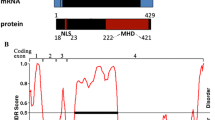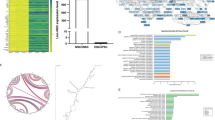Abstract
In mammals, the type II melanoma antigen (MAGE) protein family is constituted by at least ten closely related members, but our understanding of their function in the developing nervous system remains poor. To systematically study the expression pattern of type II MAGE genes during neurogenesis, we employed mouse embryonic carcinoma P19 cells as an in vitro model for neural differentiation by retinoic acid (RA) induction. The expression of type II MAGE genes was investigated under distinct steps of differentiation by a comparative ΔΔC T paradigm of real-time quantitative reverse-transcription PCR (qRT-PCR). The relative levels of each gene expression at various steps of differentiation were expressed as a fold change compared with that in RA-untreated P19 cells. The results revealed that: (1) the expression of MAGE-E1, E2, and Necdin transcripts was steadily increased, and the relative levels of MAGE-D1, D2, D3, F1, G1, and H1 mRNA were fluctuantly elevated after the RA-treatment at embryoid body and neural stages; (2) during RA-treatment and subsequent differentiation, the expression of MAGE-L2 mRNA was decreased. Therefore, our results suggested that MAGE-D1, D2, D3, E1, E2, F1, G1, H1, and Necdin might be involved in the early process of neurogenesis, and MAGE-L2 connected with maintenance of pluripotency of stem cells. These studies may present some clues for a better understanding of the fundamental aspects of type II MAGE genes during neurogenesis.




Similar content being viewed by others
Abbreviations
- MAGE:
-
Melanoma antigen
- RA:
-
Retinoic acid
- qRT-PCR:
-
Quantitative reverse-transcription PCR
- MHD:
-
MAGE homology domain
- GAPDH:
-
Glyceraldehyde-3-phosphate dehydrogenase
- GAP43:
-
Growth-associated protein 43
- C T :
-
Threshold cycle
- EBs:
-
Embryonic bodies
- h:
-
Hour
- d:
-
Day
- RT:
-
Room temperature
References
Aizawa T, Maruyama K, Kondo H, Yoshikawa K (1992) Expression of necdin, an embryonal carcinoma-derived nuclear protein, in developing mouse brain. Brain Res Dev Brain Res 68:265–274
Alam AH, Suzuki H, Tsukahara T (2009) Expression analysis of Fgf8a &Fgf8b in early stage of P19 cells during neural differentiation. Cell Biol Int 33:1032–1037
Bain G, Ray WJ, Yao M, Gottlieb DI (1994) From embryonal carcinoma cells to neurons: the P19 pathway. BioEssays 16:343–348
Barker PA, Salehi A (2002) The MAGE proteins: emerging roles in cell cycle progression, apoptosis, and neurogenetic disease. J Neurosci Res 67:705–712
Barrett GL, Bartlett PF (1994) The p75 nerve growth factor receptor mediates survival or death depending on the stage of sensory neuron development. Proc Natl Acad Sci USA 91:6501–6505
Barrett GL, Greferath U, Barker PA, Trieu J, Bennie A (2005) Co-expression of the P75 neurotrophin receptor and neurotrophin receptor-interacting melanoma antigen homolog in the mature rat brain. Neuroscience 133:381–392
Chibuk TK, Bischof JM, Wevrick R (2001) A necdin/MAGE-like gene in the chromosome 15 autism susceptibility region: expression, imprinting, and mapping of the human and mouse orthologues. BMC Genet 2:22
Chomez P, De Backer O, Bertrand M, De Plaen E, Boon T, Lucas S (2001) An overview of the MAGE gene family with the identification of all human members of the family. Cancer Res 61:5544–5551
Clotman F, De Backer O, De Plaen E, Boon T, Picard J (2000) Cell- and stage-specific expression of mage genes during mouse spermatogenesis. Mamm Genome 11:696–699
Dussault AA, Pouliot M (2006) Rapid and simple comparison of messenger RNA levels using real-time PCR. Biol Proced Online 8:1–10
Frade JM, Rodriguez-Tebar A, Barde YA (1996) Induction of cell death by endogenous nerve growth factor through its p75 receptor. Nature 383:166–168
Ito S, Kawano Y, Katakura H, Takenaka K, Adachi M, Sasaki M, Shimizu K, Ikenaka K, Wada H, Tanaka F (2006) Expression of MAGE-D4, a novel MAGE family antigen, is correlated with tumor-cell proliferation of non-small cell lung cancer. Lung Cancer 51:79–88
Jordan BW, Dinev D, LeMellay V, Troppmair J, Gotz R, Wixler L, Sendtner M, Ludwig S, Rapp UR (2001) Neurotrophin receptor-interacting mage homologue is an inducible inhibitor of apoptosis protein-interacting protein that augments cell death. J Biol Chem 276:39985–39989
Kawano Y, Sasaki M, Nakahira K, Yoshimine T, Shimizu K, Wada H, Ikenaka K (2001) Structural characterization and chromosomal localization of the MAGE-E1 gene. Gene 277:129–137
Kuwajima T, Taniura H, Nishimura I, Yoshikawa K (2004) Necdin interacts with the Msx2 homeodomain protein via MAGE-D1 to promote myogenic differentiation of C2C12 cells. J Biol Chem 279:40484–40493
Kuwako K, Taniura H, Yoshikawa K (2004) Necdin-related MAGE proteins differentially interact with the E2F1 transcription factor and the p75 neurotrophin receptor. J Biol Chem 279:1703–1712
Lee S, Kozlov S, Hernandez L, Chamberlain SJ, Brannan CI, Stewart CL, Wevrick R (2000) Expression and imprinting of MAGEL2 suggest a role in Prader–Willi syndrome and the homologous murine imprinting phenotype. Hum Mol Genet 9:1813–1819
Malinen E, Kassinen A, Rinttila T, Palva A (2003) Comparison of real-time PCR with SYBR Green I or 5′-nuclease assays and dot-blot hybridization with rDNA-targeted oligonucleotide probes in quantification of selected faecal bacteria. Microbiology 149:269–277
Maruyama K, Usami M, Aizawa T, Yoshikawa K (1991) A novel brain-specific mRNA encoding nuclear protein (necdin) expressed in neurally differentiated embryonal carcinoma cells. Biochem Biophys Res Commun 178:291–296
Masse J, Piquet-Pellorce C, Viet J, Guerrier D, Pellerin I, Deschamps S (2011) ZFPIP/Zfp462 is involved in P19 cell pluripotency and in their neuronal fate. Exp Cell Res 317:1922–1934
McBurney MW, Jones-Villeneuve EM, Edwards MK, Anderson PJ (1982) Control of muscle and neuronal differentiation in a cultured embryonal carcinoma cell line. Nature 299:165–167
Niinobe M, Koyama K, Yoshikawa K (2000) Cellular and subcellular localization of necdin in fetal and adult mouse brain. Dev Neurosci 22:310–319
Osterlund C, Tohonen V, Forslund KO, Nordqvist K (2000) Mage-b4, a novel melanoma antigen (MAGE) gene specifically expressed during germ cell differentiation. Cancer Res 60:1054–1061
Palmer S, Wiegand AP, Maldarelli F, Bazmi H, Mican JM, Polis M, Dewar RL, Planta A, Liu S, Metcalf JA, Mellors JW, Coffin JM (2003) New real-time reverse transcriptase-initiated PCR assay with single-copy sensitivity for human immunodeficiency virus type 1 RNA in plasma. J Clin Microbiol 41:4531–4536
Saburi S, Nadano D, Akama TO, Hirama K, Yamanouchi K, Naito K, Tojo H, Tachi C, Fukuda MN (2001) The trophinin gene encodes a novel group of MAGE proteins, magphinins, and regulates cell proliferation during gametogenesis in the mouse. J Biol Chem 276:49378–49389
Salehi AH, Roux PP, Kubu CJ, Zeindler C, Bhakar A, Tannis LL, Verdi JM, Barker PA (2000) NRAGE, a novel MAGE protein, interacts with the p75 neurotrophin receptor and facilitates nerve growth factor-dependent apoptosis. Neuron 27:279–288
Sasaki M, Nakahira K, Kawano Y, Katakura H, Yoshimine T, Shimizu K, Kim SU, Ikenaka K (2001) MAGE-E1, a new member of the melanoma-associated antigen gene family and its expression in human glioma. Cancer Res 61:4809–4814
Sasaki A, Masuda Y, Iwai K, Ikeda K, Watanabe K (2002) A RING finger protein Praja1 regulates Dlx5-dependent transcription through its ubiquitin ligase activity for the Dlx/Msx-interacting MAGE/necdin family protein, Dlxin-1. J Biol Chem 277:22541–22546
Sasaki A, Hinck L, Watanabe K (2005) RumMAGE-D the members: structure and function of a new adaptor family of MAGE-D proteins. J Recept Signal Transduct Res 25:181–198
Stone B, Schummer M, Paley PJ, Crawford M, Ford M, Urban N, Nelson BH (2001) MAGE-F1, a novel ubiquitously expressed member of the MAGE superfamily. Gene 267:173–182
Taniguchi N, Taniura H, Niinobe M, Takayama C, Tominaga-Yoshino K, Ogura A, Yoshikawa K (2000) The postmitotic growth suppressor necdin interacts with a calcium-binding protein (NEFA) in neuronal cytoplasm. J Biol Chem 275:31674–31681
Taniura H, Yoshikawa K (2002) Necdin interacts with the ribonucleoprotein hnRNP U in the nuclear matrix. J Cell Biochem 84:545–555
Taniura H, Taniguchi N, Hara M, Yoshikawa K (1998) Necdin, a postmitotic neuron-specific growth suppressor, interacts with viral transforming proteins and cellular transcription factor E2F1. J Biol Chem 273:720–728
Tcherpakov M, Bronfman FC, Conticello SG, Vaskovsky A, Levy Z, Niinobe M, Yoshikawa K, Arenas E, Fainzilber M (2002) The p75 neurotrophin receptor interacts with multiple MAGE proteins. J Biol Chem 277:49101–49104
Uetsuki T, Takagi K, Sugiura H, Yoshikawa K (1996) Structure and expression of the mouse necdin gene. Identification of a postmitotic neuron-restrictive core promoter. J Biol Chem 271:918–924
Wang T, Brown MJ (1999) mRNA quantification by real time TaqMan polymerase chain reaction: validation and comparison with RNase protection. Anal Biochem 269:198–201
Wang X, Bauer JH, Li Y, Shao Z, Zetoune FS, Cattaneo E, Vincenz C (2001) Characterization of a p75(NTR) apoptotic signaling pathway using a novel cellular model. J Biol Chem 276:33812–33820
Williams ME, Strickland P, Watanabe K, Hinck L (2003) UNC5H1 induces apoptosis via its juxtamembrane region through an interaction with NRAGE. J Biol Chem 278:17483–17490
Winer J, Jung CK, Shackel I, Williams PM (1999) Development and validation of real-time quantitative reverse transcriptase-polymerase chain reaction for monitoring gene expression in cardiac myocytes in vitro. Anal Biochem 270:41–49
Acknowledgments
This study was supported by grants from Chinese National Basic Research Program (Grant No. 2009CB918301), and Beijing Municipal Natural Science Foundation (Grant No. 5112027).
Author information
Authors and Affiliations
Corresponding author
Rights and permissions
About this article
Cite this article
Liu, Y., Yang, S., Yang, J. et al. Relative Expression of Type II MAGE Genes During Retinoic Acid-Induced Neural Differentiation of Mouse Embryonic Carcinoma P19 Cells: A Comparative Real-Time PCR Analysis. Cell Mol Neurobiol 32, 1059–1068 (2012). https://doi.org/10.1007/s10571-012-9826-2
Received:
Accepted:
Published:
Issue Date:
DOI: https://doi.org/10.1007/s10571-012-9826-2




